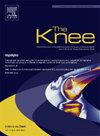同种异体软组织移植重建前交叉韧带的胫骨固定:皮质悬吊装置与孔径干涉螺钉
IF 2
4区 医学
Q3 ORTHOPEDICS
引用次数: 0
摘要
本研究旨在比较全内技术(全内组)或生物可吸收螺钉孔固定技术(孔固定组)胫骨侧固定应用同种胫骨肌腱进行前交叉韧带重建(ACLR)后胫骨隧道扩宽的临床结果。方法对2012 ~ 2022年36例患者进行回顾性分析。采用股骨悬吊固定接受同种胫骨肌腱单束解剖ACLR的患者根据胫骨固定方式分为两组:可调节悬吊固定装置或生物可吸收螺钉开孔固定技术。结果全内固定技术需要较小的皮肤切口(约5mm)进行胫骨固定。在术后1年的x线片上,两组之间的隧道直径在孔径水平上没有显著差异。全内组在中物质水平下隧道扩大较多(P = 0.044)。All-inside组术后1年MRI显示孔径水平的横断面积(CSA)明显大于中物质水平(P = 0.003)。全内固定组在插入侧和中物质水平的CSA增量大于孔径固定组。临床结果测量没有观察到显著差异,包括Lysholm评分,Tegner活动水平。术后2年随访,全内组手术失败发生率较高,既往运动恢复率明显降低。结论软同种异体骨内固定技术在术后2年随访中表现出美观优势和良好的临床效果,但在术后1年随访中表现出比生物可吸收干涉螺钉开孔固定技术更大的胫骨隧道加宽。本文章由计算机程序翻译,如有差异,请以英文原文为准。
Tibial fixation in anterior cruciate ligament reconstruction using soft-tissue allograft: Cortical suspensory device versus aperture interference screw
Background
This study aimed to compare clinical outcomes and tibial tunnel widening following anterior cruciate ligament reconstruction (ACLR) using allo-tibialis tendon performed with an all-inside technique (All-inside group) or an aperture fixation technique with a bioabsorbable screw (Aperture fixation group) for tibial side fixation.
Methods
A retrospective analysis of 36 patients between 2012 and 2022 was conducted. Patients who received a single-bundle anatomical ACLR with allo-tibialis tendon using suspensory femoral fixation were divided into two groups according to tibial fixation methods: adjustable suspensory fixative device or aperture fixation technique with a bioabsorbable screw.
Results
All-inside technique required a smaller skin incision (<5 mm) for tibial fixation. At postoperative 1-year radiographs, tunnel diameter showed no significant difference at the aperture level between both groups. More tunnel enlargement was observed in the All-inside group at the mid-substance level (P = 0.044). Postoperative 1-year MRI in the All-inside group showed a significantly larger cross-sectional area (CSA) at the aperture level than the mid-substance level (P = 0.003). CSA increments were larger in the All-inside group than the Aperture fixation group at insertion side and mid-substance level. No significant differences in clinical outcome measures were observed, including the Lysholm score, Tegner activity level. All-inside group showed higher failure cases and significantly lower rate of return to previous sports at postoperative 2-year follow up.
Conclusions
All-inside technique with soft allograft demonstrated cosmetic superiority and non-inferior clinical outcomes at the median 2-year follow up but showed larger tibial tunnel widening than aperture fixation technique with a bioabsorbable interference screw at the postoperative 1-year follow up.
求助全文
通过发布文献求助,成功后即可免费获取论文全文。
去求助
来源期刊

Knee
医学-外科
CiteScore
3.80
自引率
5.30%
发文量
171
审稿时长
6 months
期刊介绍:
The Knee is an international journal publishing studies on the clinical treatment and fundamental biomechanical characteristics of this joint. The aim of the journal is to provide a vehicle relevant to surgeons, biomedical engineers, imaging specialists, materials scientists, rehabilitation personnel and all those with an interest in the knee.
The topics covered include, but are not limited to:
• Anatomy, physiology, morphology and biochemistry;
• Biomechanical studies;
• Advances in the development of prosthetic, orthotic and augmentation devices;
• Imaging and diagnostic techniques;
• Pathology;
• Trauma;
• Surgery;
• Rehabilitation.
 求助内容:
求助内容: 应助结果提醒方式:
应助结果提醒方式:


